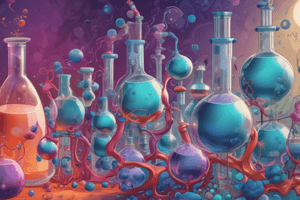Podcast
Questions and Answers
What is the basic unit of matter in physical pharmacy?
What is the basic unit of matter in physical pharmacy?
- Molecule
- Compound
- Element
- Atom (correct)
Which type of property depends on the sum of the individual properties of the components present in a system?
Which type of property depends on the sum of the individual properties of the components present in a system?
- Additive Property (correct)
- Extensive Property
- Colligative Property
- Constitutive Property
What is the type of bond formed by the transfer of electrons between atoms?
What is the type of bond formed by the transfer of electrons between atoms?
- Ionic Bond (correct)
- Polar Bond
- Nonpolar Bond
- Covalent Bond
Which of the following is an example of an extensive property?
Which of the following is an example of an extensive property?
What is the study of the rates of chemical reactions?
What is the study of the rates of chemical reactions?
Which type of property depends on the type and arrangement of the components present in a system?
Which type of property depends on the type and arrangement of the components present in a system?
What type of transition is reversible?
What type of transition is reversible?
Which method of forming liquid crystals uses a solvent?
Which method of forming liquid crystals uses a solvent?
What is the minimum pressure required to liquefy a gas at its critical temperature?
What is the minimum pressure required to liquefy a gas at its critical temperature?
Which analytical technique is used to determine the crystal structure of a solid?
Which analytical technique is used to determine the crystal structure of a solid?
What is the state of matter characterized by rapid motion and weak intermolecular forces?
What is the state of matter characterized by rapid motion and weak intermolecular forces?
What is the temperature above which a gas cannot be liquefied?
What is the temperature above which a gas cannot be liquefied?
What is a characteristic of solids in terms of their kinetic energy?
What is a characteristic of solids in terms of their kinetic energy?
What is the difference between crystalline and amorphous solids in terms of solubility?
What is the difference between crystalline and amorphous solids in terms of solubility?
What is unique about the melting point of amorphous solids?
What is unique about the melting point of amorphous solids?
What is a characteristic of clathrates?
What is a characteristic of clathrates?
What is a characteristic of solvates in terms of solubility?
What is a characteristic of solvates in terms of solubility?
What is a characteristic of polymorphs?
What is a characteristic of polymorphs?
Study Notes
Physical Pharmacy
- Physical pharmacy applies physical and chemical principles and laws to develop dosage forms and drug delivery systems.
Forces of Attraction
- Atoms are the basic units of matter, consisting of protons, neutrons, and electrons.
- Intermolecular forces include:
- Ionic Bond: transfer of electrons
- Covalent Bond: sharing of electrons
- Polar (unequal sharing)
- Nonpolar (equal sharing)
Physical Properties of Systems
- Additive Property: depends on the sum of individual properties of components
- Constitutive Property: depends on the type and arrangement of components
- Colligative Property: depends on the number of components
- Types of Properties:
- Extensive/Extrinsic: depends on the size or amount of material (e.g., mass, volume, area)
- Intensive/Intrinsic: does not depend on the size or amount of material (e.g., density, melting point, boiling point)
States of Matter
- Solid: fixed shape, nearly incompressible, strong intermolecular forces, little kinetic energy
- Liquid: takes shape of container, incompressible, some kinetic energy
- Gas: fills available space, compressible, rapid motion, weak intermolecular forces
- Plasma (Mesophase/Liquid Crystal): intermediate phase between solid and liquid
- Types: Smectic, Nematic, Cholesteric
- Supercritical Fluid State: between liquid and gas
- Liquefaction of Gases: critical temperature (Tc) and critical pressure (Pc) determine liquefaction
Solids
- Crystalline Solids: have definite geometric forms, 6 common crystalline structures (cubic, tetragonal, etc.)
- Amorphous Solids (Glasses or Supercooled Liquids): non-crystalline, no definite order, no sharp melting point
- Clathrates: trap a molecule within its lattice, lack reproducibility
- Solvates: have a solvent within the lattice (e.g., hydrates)
- Polymorphs: have different physical properties, including melting points and solubilities
Studying That Suits You
Use AI to generate personalized quizzes and flashcards to suit your learning preferences.
Description
Assess your understanding of physical pharmacy concepts, including forces of attraction, states of matter, and chemical kinetics, as applied in pharmaceutical sciences and dosage form development. This quiz covers the essential topics in Module 5 of the Pharmacy Assessment Program at Saint Louis University.



